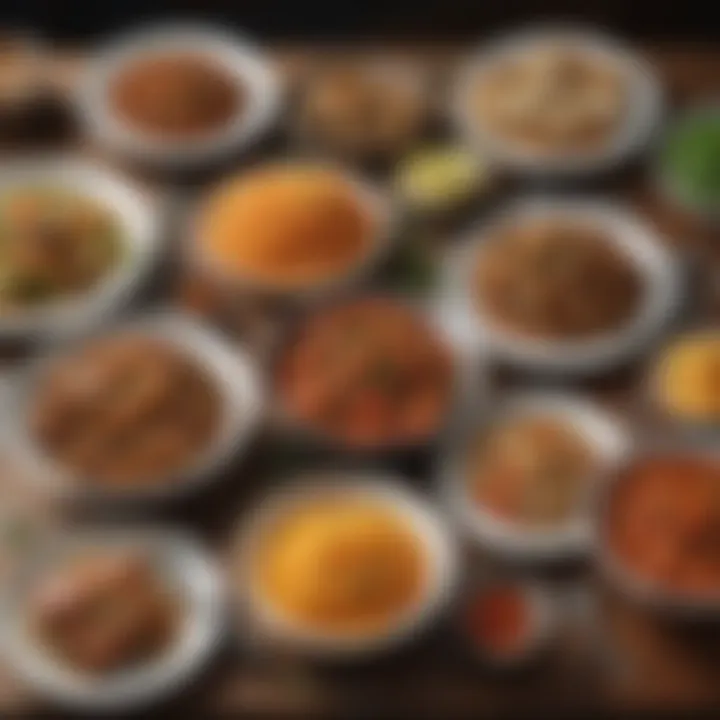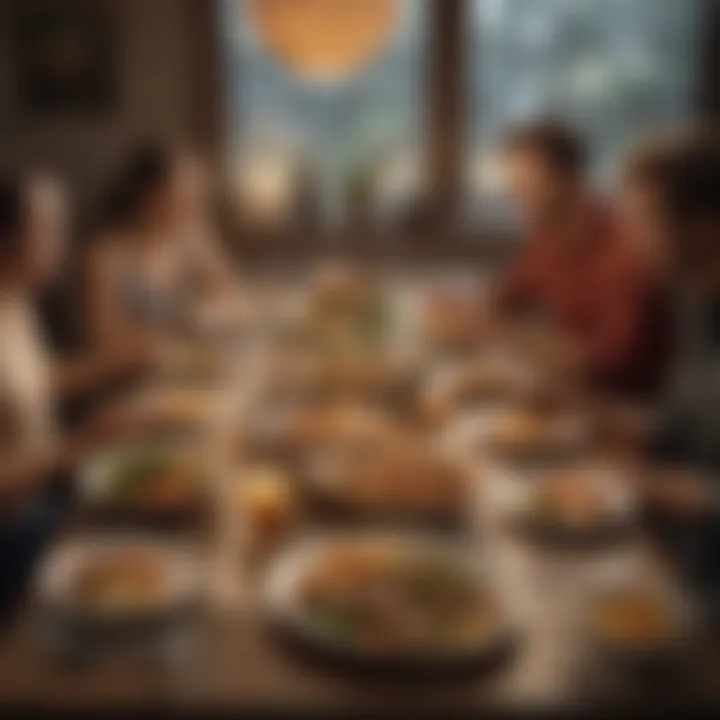Quick Dinner Ideas for Eight: Simple and Delicious Meals


Intro
Preparing dinner for eight people can seem overwhelming at first. Yet, with the right approach and planning, it can become a simple task instead. This section will explore quick meal options that bring both efficiency and satisfaction to any weeknight gathering. Understanding how to simplify the cooking process fosters a more enjoyable experience at the table and allows for enjoyable conversations.
In the subsequent sections, we will delve into practical recipes, tips, and chances to customize meals, thereby diversifying your repertoire of quick dinner ideas. Readers will gain insight into easily adjustable meals that cater to various dietary preferences and flavors, ensuring all guests feel included and happy.
Recipe Highlight
One-Pan Lemon Herb Chicken and Vegetables
- Ingredients:
- Estimated Time: 30 minutes
- Servings: 8
- 8 boneless chicken breasts
- 4 cups of mixed vegetables (e.g., bell peppers, broccoli, and carrots)
- 3 lemons
- 1 tablespoon of olive oil
- 2 teaspoons of dried herbs (e.g., thyme, oregano)
- Salt and pepper to taste
This dish is a dynamic centerpiece that satisfies diverse palates combined with a moderate amount of preparation. The bright tang of lemon beautifully balances the flavors of the chicken and vegetables.
Step-by-Step Instructions
- Prepare the Ingredients:
- Start by preheating your oven to 400°F (200°C).
- Slice the lemons into wedges and set aside.
- Chop the mixed vegetables into manageable pieces.
- Seasoning the Chicken:
- In a large mixing bowl, coat the chicken breasts with olive oil, salt, pepper, and dried herbs. Ensure the chicken is evenly seasoned to enhance the taste.
- Arranging on a Baking Sheet:
- Place the chicken breasts in the middle of a large baking sheet.
- Surround them with the chopped vegetables and lemon wedges. Dispense additional salt and pepper on top of vegetables if desired.
- Bake:
- Cook in the oven for about 25 minutes or until the internal temperature of the chicken reaches 165°F (75°C). Basting with lemon juice once halfway through enhances flavor.
- Serve:
- Once cooked, let it rest for approximately 5 minutes before serving. Present the chicken on a large platter for an inviting display.
Insider Tips
- Make sure not to overcrowd the baking sheet. This helps with even cooking and browning.
- If using frozen vegetables, remember they may require longer to cook.
Variations and Substitutions
- Instead of chicken, try using salmon fillets for an equally delightful dish.
- Additionally, you can replace the mixed vegetables with seasonal vegetables such as zucchini or asparagus based on preference.
- For added flavor, consider a sprinkle of fresh herbs right before serving or an extra dash of lemon zest.
Sides
- To complement the meal, pair it with quinoa salad or garlic bread. This builds a more diverse dining experience.
Time-Saving Cooking Tips
- Prep Ahead: Consider slicing vegetables the night before to save time. Store them in airtight containers to keep them fresh.
- Utilize a food processor for chopping large quantities quickly.
- Make extra portions to enjoy throughout the week. Leftovers work wonderfully in salads or wraps.
Nutritional Information
- Caloric Content: Approximately 300 calories per serving.
- Key Nutrients: Healthy source of protein; includes vitamins A and C from the vegetables.
- Suitable for many diet plans including gluten-free and low-carb. For vegan needs, replace chicken with hearty vegetables or tofu options.


Remember, preparing dinner for a larger group does not have to cause stress. Embracing detailed guidelines and these recommendations allows any cook to feel accomplished in the kitchen.
Understanding the Challenge
Cooking dinner for a large group, such as eight people, can often seem daunting. The concept of quick meals takes on significant importance in this context, particularly for busy weeknights. Many find it necessary to find recipes that balance time, effort, and palatability. So what are some of the benefits and considerations when it comes to understanding this challange?
The Importance of Quick Meals
Quick meals serve a dual function. First, they alleviate stress during hectic evenings where individual schedules may vary significantly. Preparing meals that can be done swiftly gives home cooks time to unwind and focus on family or friends rather than constantly worrying about dinner preparations. Meals like a one-pan chicken and vegetables or beef stir-fry can be thrown together rather quickly, allowing for more quality time.
Moreover, quick meals can help promote healthy eating. As time becomes limited, the tendency might be to opt for convenience foods rather than nutritious ones. Having a toolkit of quick meal solutions enables families to enjoy satisfying dinners without compromising on dietary quality. Nutritional balance becomes easier to maintain when the full scope of meal options is readily accessible and appears feasible, even on a busy day.
Common Barriers to Cooking for Eight
Cooking for a larger group creates distinct challenges that people must navigate. One major barrier is the effort to scale recipes appropriately. Most recipes cater directly to families of four, making it occasionally tricky to extend them to more mouths without making mistakes. Miscalculations in proportions can lead to either undercooked options or excessive leftovers.
Another relevant issue is time; busy households often struggle with overlapping commitments, shifting one’s focus from meal preparation. It is easy to gear up for a larger batch only to find that an unexpected activity or work commitment derails the momentum. Further, limited cooking experience can cause hesitancy. For novice cooks, the fear of failure could impact interest in trying out new recipes, interpretating them as potential disasters in the making if not carried out seamlessly.
Lastly, available equipment may or may not suit large-quantity cooking. Home kitchens can often lack needed tools such as sufficient pot sizes, graters, or dishs for organized prep. This forces individuals to develop workarounds that can be tedious or inefficient. Ensuring that one approaches cooking with clarity and finesse is crucial.
In summary, addressing these barriers helps to ease the stress while equipping home cooks with the tools they need to create enjoyable meals for a larger gathering.
Acknowledging these barriers informs the upcoming culinary planning, reporting not only on quick meal strategies, but identifying make-shift solutions for typical hindrances associated to delivering suitably crafted cuisine.
Culinary Planning Essentials
Planning is crucial for any cooking endeavor, and it becomes even more important when preparing meals for a larger group. The process of culinary planning involves strategizing how ingredients, preparation time, and cooking methods come together to create seamless meals. Using effective planning is essential in offering quick dinner options while removing stress and unnecessary complexity. It enables cooks to meet diverse tastes and restrictions based on individual preferences, which can vary in a group setting.
Meal Prepping for Success
Meal prepping is a tactic many cooks underestimate. It involves preparing ingredients or entire meals ahead of time. This means that time spent during the week is significantly reduced. By chopping vegetables, marinating proteins, and measuring spices in advance, one can have almost everything ready when the need arises.
- Spend an hour on the weekend to prepare items for the week.
- Use clear containers to store prepped items, helping to maintain freshness and visibility.
- Plan for future meals by using similar ingredients through different recipes. For example, chicken can feature in salads, stir-fries, or wraps, thus making the most of meal prep time.
The act of meal prepping not only streamlines the cooking process but leads to greater food safety. By adhering to proper food storage techniques, the risk of spoilage and waste diminishes.
Choosing Versatile Ingredients
Key to successful meal planning is selecting versatile ingredients. These are items that have multiple uses in various recipes. Versatile ingredients save money and reduce the clutter in the pantry. Therefore, understanding their role can change the entire meal preparation experience.
For instance, chicken thighs are not only ideal for grilling but can also be used in soups or casseroles.
- Opt for disponibly produce, ensuring freshness and continued taste through meals.
- Keep essentials like rice, quinoa, and beans on hand. They serve as good bases compatible with a number of ingredients.
- Herbs and spices like parsley or cumin can be utilized for flavor in both meat and vegetable dishes.
Ultimately, choosing versatile ingredients eases the experience of cooking for larger groups. You save time and energy while elevating meals, transforming each dish into something worthy of sharing with friends and family.
Culinary planning does not merely revolve around cooking; it is the backbone to developing quick meals vital for larger groups.
Finale
This section will summarize how to specifically apply these strategies to large groups without complexity. Emphasize creativity through recipe variation and encourage experimentation within different dietary needs.
Catering to Dietary Restrictions
Catering to dietary restrictions is crucial when planning meals for larger groups. A varied selection of meal options ensures that everyone can partake in the dining experience without exclusion. Addressing various dietary needs showcases consideration and enhances the overall enjoyment of the meal. Furthermore, it encourages creativity in meal preparation, which can lead to discovering new recipes and flavors. Keeping dietary restrictions in mind does not only fulfill health-related needs but increases the appeal of your offering.
Vegetarian and Vegan Options


Stuffed Peppers
Stuffed peppers are a classic dish that showcases how versatile and visually appealing vegetarian meals can be. This dish typically features colorful bell peppers filled with a mixture of grains, beans, vegetables, and spices. The key characteristic of stuffed peppers is their capacity to be customized according to taste preferences and ingredient availability, making them a beneficial choice for any group.
A unique aspect is their dairy-free capability. This means they are approachable for vegans too, and with various filling options, choosing legumes or quinoa ensures a good protein source. However, one consideration might be the cooking time required to roast the peppers until tender, which while manageable, may require some advance planning to ensure they are enjoyed perfectly.
Chickpea Salad
Chickpea salad embodies the mob often healthy options for a quick meal. It can consist of various sawy ingredients like cucumbers, tomatoes, herbs dressed in olive oil and vinegar. Its key characteristic is its ease of preparation, as it requires minimal cooking and simply assembling of fresh ingredients. Being nutrient-rich makes chickpea salad a popular choice in this arena, providing ample fiber and protein without demonstrating heaviness often accompanying other dishes. One of its unique features is the variety of textures that can be achieved, but you might need to ensure your group likes chickpeas as an established flavor.
Gluten-Free Alternatives
Quinoa Bowls
Quinoa bowls present a scrumptious way to cater to gluten-free needs, while also packing valuable nutrients. Quinoa itself is a gluten-free grain and is rich in protein and fiber, making it an excellent base for various flavors and toppings. This adaptability is a significant aspect of quinoa bowls; you can include beans, various vegetables, and even avocado, making them a popular meal choice.
A unique advantage lies in how quickly they can be prepared, offering a filling option without lengthy prep methods. Yet, it does require advance cooking of quinoa that can strain some people.
Zucchini Noodles
Zucchini noodles have gained significant attention as a versatile gluten-free alternative to traditional pasta. By spiralizing zucchini, this dish transforms a simple vegetable into a stylish centerpiece. A key characteristic of zucchini noodles is their ability to absorb flavors of accompanying sauces, providing a light, vibrant choice for dishes. Zucchini noodles become a beneficial and fun option to recreate many pasta recipes in a health-oriented form.
However, a notable cons is the relatively short cooking time or cooked temperature requirement dictated to preserve the composition. This aspect might not lead to ideal results if prepped too far ahead. Hence, timing in serving becomes very crucial.
Planning ahead can maximize enjoyment and minimize cooking pressure.
Nutritional Considerations
Nutritional considerations play a vital role in planning meals for a large group, ensuring that everyone enjoys flavorful food without sacrificing health. Understanding the balance between satisfaction and nutrition can enhance the dining experience. In this section, we will assess the importance of balanced meals and how to incorporate essential nutrients for varied diets.
Balancing Macronutrients
While preparing meals for eight, it's crucial to consider macronutrients: proteins, carbohydrates, and fats. Each offers unique benefits:
- Proteins are essential for repair and growth. Options include grilled chicken, tofu, and legumes.
- Carbohydrates provide energy. Choose whole grains like quinoa or brown rice for added fiber.
- Fats support nutrient absorption and immune function. Avocados, nuts, and olive oil are good choices.
By combining these macronutrients, meals can be both satisfying and nutritious. A well-rounded dinner helps regulate blood sugar while ensuring adequate energy throughout the evening.
Moreover, it helps in keeping diners full, reducing the desire for post-meal snacks.
Incorporating Vegetables
Vegetables are crucial for nutrition and flavor. Adding them increases vitamins, minerals, and fiber in meals. Consider these points when choosing vegetables:
- Variety: Include different colors to maximize nutrient intake. Each color usually represents different vitamins and antioxidants.
- Prep Style: Opt for methods that enhance taste. Roasting can bring out sweetness, while steaming retains nutrients.
- Portion Control: Ensure that half of the plate consists of vegetables. This ratio helps in easily meeting daily intake recommendations.
Utilizing seasonal produce can create freshness and variety. For instance, summer might invite zucchini and corn, while winter offers hearty root vegetables.
A focus on a diversity of vegetables not only balances your meals but can also introduce new flavors that elevate your dining experience.
Integrating these nutritional considerations will benefit both health and taste, thus simplifying the process of cooking for a larger group.
Making the Most of Leftovers
Making the most of leftovers is not just a practical aspect of meal preparation, but it also ties into sustainable cooking practices and efficient resource utilization. When cooking for a group of eight, it is common to have extra food that can go to waste if not properly utilized. Being clever with leftovers saves time, money, and effort. This aspect of cooking molds a more resourceful mindset while catering to a larger audience.
Utilizing leftovers efficiently can transform the way you plan meals. When these ingredients are repurposed, they enrich a new dish without significant carbon or economic costs associated with fresh food procurement. Shifting the mindset to consider how leftover portions can serve as the base for upcoming meals is both a wisdom-driven essence to cooking and a sustainable approach.
While many think of leftovers merely as reheated meals, there is further potential lying in those forgotten containers. Elevated meals emerge when past dishes become creative inspiration rather than just replications. Subsequently, financial expenditures reduce as people transform remnants into new delicacies.


Proper management of leftovers not only mitigates waste but also enhances meal variety at a lean budget.
Creative Uses for Leftovers
The innovative potential for transforming leftovers into new dishes can put initiative in a household’s cooking routine. Exploring various methods opens a world away from monotonous meals, all while maximizing kitchen resources effectively. Significant creativity can turn leftover proteins, starches, or vegetables into entirely distinct flavors.
Here are some effective methods:
- Frittatas and Omelets: Leftover veggies combined with eggs can create a vibrant and flavor-rich dish in mere minutes.
- Casseroles: Layering different leftovers like rice, beans, or protein for casseroles yields an excellent method for feeding a large gathering. Pile it high and pop into the oven.
- Soups or Stews: Stock can rise to another level with remnants. Blend that last amount of chicken or turkey with vegetables to create consolidated flavors.
- Sandwiches or Wraps: Turns snagged proteins into tempting sandwiches or wraps. Adding new spreads or fresh ingredients upscales the meal experience.
- Salads: Their versatility often allows consolidating different proteins over greens, dressed up vividly, while forsaking worn aspects of older tastes.
Taking time to analyze what has isn’t ready for waste means perceptions clarify. Leftovers morph into prime components extending the gastronomical experience during repeated dinner instances. With ingenious approaches, maximizing everything left leads to thrilling culinary prospects.
Efficient Cooking Techniques
Efficient cooking techniques are a cornerstone of preparing meals for a larger group like eight people. Having the right strategies in place can save time, reduce stress, and ensure that dinner is served promptly. These techniques not only streamline the cooking process but also help to maintain the quality and taste of the dishes being prepared. In this section, we will explore two important areas: batch cooking strategies and time-saving kitchen gadgets.
Batch Cooking Strategies
Batch cooking is an approach that involves preparing larger quantities of food at once, maximizing time efficiency. The main idea is simple: rather than cooking individual meals every night, you make enough to cater to several meals. This method not only cuts down on daily prep but also optimizes your use of time and resources.
Some benefits of batch cooking include:
- Time-Saving: Spend one day or part of a day cooking rather than every day.
- Reduced Stress: Knowing meals are prepared in advance alleviates the pressure of weeknight cooking.
- Cost-Effective: Buying ingredients in bulk can lower grocery costs.
Practical steps to implementing batch cooking could have you utilizing the weekend to main dishes such as Beef Stew or Chili Con Carne. For example, prepping and cooking these dishes early allows them to marinate and develop flavors, offering greater taste in less time.
When you batch cook, it's advisable to divide the portions into suitable sizes for your family or group. Invest in good containers and label them with contents and dates for easy access later.
Time-Saving Kitchen Gadgets
Utilizing the right kitchen gadgets can truly change your cooking experience. Effective tools minimize the time and effort required to prepare meals, making the process of cooking for eight much easier.
Some essential time-saving gadgets include:
- Instant Pot: This multi-cooker can speed up various cooking tasks, from pressure cooking to frying.
- Food Processor: This machine handles chopping, mixing, and blending, saving time on pre-cooking prep.
- Slow Cooker: While it may not seem like a time-saver, it allows meal preparation ahead of time and cooks meals slowly while you attend to other tasks.
When you equip your kitchen with gadgets like these, your cooking tasks can become less burdened and allow you to focus more on making quick and delicious meals.
'Efficiency in the kitchen leads to innovation and creativity in meal preparation.' - Unknown
Incorporating efficient cooking techniques into your approach can dramatically simplify the process for serving groups, freeing you from stress and enhancing the joy of gathering with family and friends.
Finale
In the realm of cooking for eight, efficiency and creativity must go hand in hand. This article highlights two major aspects of cooking for larger groups: its significance and practical solutions. The importance of simplifying weeknight meals cannot be overstated. Emphasizing quick and delicious dishes enables busy families or groups to share nourishing meals without lengthy preparations. The stress that commonly arises with traditional cooking for many can be alleviated by utilizing the strategies discussed.
Recap of Quick Dinner Solutions
The quick dinner solutions introduced in this guide range from one-pan dishes to reheating grilled meats and comprehensive crockpot meals. Each category is designed to be practical. Consider the journey through stove-top frying heer, where quick stir-fried beef and broccoli shines as both tasty and efficient. Moreover, the inclusion of slow cooker meals like chili con carne allows ample preparation in advance. More than mere recipes, these solutions offer possibilities for social interaction and creating moments
Quick and effective meals enable connection over food, which is often a cornerstone of community.
Emphasizing that cooking does not have to be overwhelming promotes positive engagement with food, especially during busy weeknights. Together, these approaches provide various avenues to approach complex nutrition challenges in an uncomplicated way.
Encouragement to Experiment
Experimentation plays a pivotal role in transforming generic recipes into personal expressions of creativity. Quick meals provide an opportunity to push boundaries not only within flavour combinations but also in culinary techniques. Encourage households to alternate spices or adapt recipes based on local ingredients. For instance, trying different vegetables in stir-fried dishes or swapping proteins can both nurture individual preferences and broaden horizons.
Fostering a sense of sustainability in kitchen practices can also resonate. Reimagining leftovers as core elements of meals encourages resourcefulness, cultivating an enriching atmosphere around food.
Having agency in the kitchen empowers families to explore how shared platters can adapt tutorials into vibrant routines. Replacing predictions like time investment with discoveries can inspire renewed enthusiasm. This approach not only enhances path uniqueness but also deepens bonds, turning shared meals into extraordinary experiences.
Overall, successful meal preparations for eight hinge significantly on tactics that prioritize flavour and simplicity while also inviting innovation and collaboration. Embracing flexibility is a central tenet that can ease the daunting task of feeding a crowd while promoting culinary enjoyment. But fundamentally, a blend of efficiency alongside individual expression can facilitate delightful dining experiences enticing to all.







